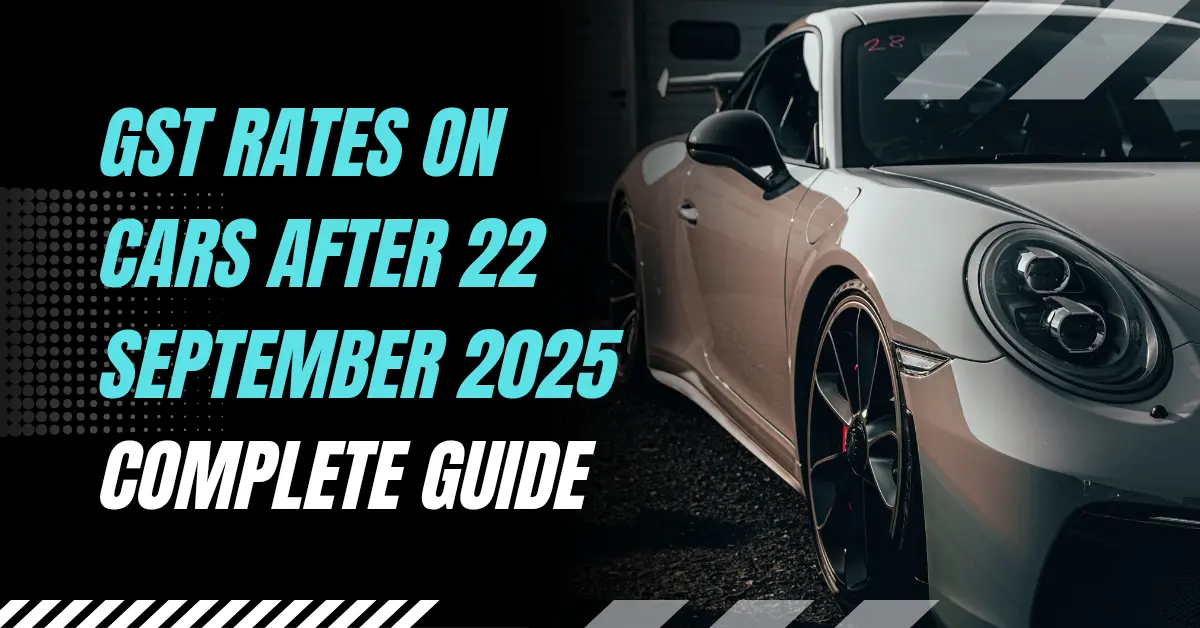The Indian automotive landscape is undergoing a monumental transformation. Following the landmark decisions of the 56th GST Council meeting, the government has ushered in a new era of taxation. Effective from September 22, 2025, the new GST rates on cars will reshape pricing for both consumers and manufacturers. Whether you’re planning to buy a new car or are simply an industry enthusiast, understanding these changes is crucial.
The goal of this reform, as stated by the government, is to simplify the tax structure, boost demand, and provide relief to the common man, especially for first-time car buyers.
This in-depth guide will not only detail the new tax slabs but also provide a comparative analysis, a breakdown of how it affects different vehicle segments, and what you can expect as a buyer.
Understanding the New GST Rates on Cars
The previous GST structure for automobiles was a complex web of GST rates and compensation cess, leading to a total tax burden that varied significantly. The new “GST 2.0” reform simplifies this by consolidating the tax slabs and, most notably, eliminating the compensation cess entirely.
Here is a breakdown of the new GST rates on cars:
- Small Cars: The GST rate for small cars has been drastically reduced from 28% to a new, simplified 18%. This category includes petrol, LPG, or CNG cars with an engine capacity up to 1200 cc and a length up to 4000 mm. It also applies to diesel cars with an engine capacity up to 1500 cc and a length up to 4000 mm.
- Mid-size and Large Cars: Vehicles that don’t meet the “small car” criteria will now attract a flat 40% GST. This new, higher slab applies to mid-size cars, large cars, and luxury vehicles with no compensation cess.
- Utility Vehicles (SUVs, MUVs, etc.): This is a significant change. Previously, SUVs attracted a high compensation cess, bringing the total tax to around 50%. Under the new regime, Utility Vehicles (with an engine capacity exceeding 1500 cc, length over 4000 mm, and ground clearance of 170 mm or more) will also fall under the new 40% GST slab, with no cess.
- Electric Vehicles (EVs): In a continued push for green mobility, the GST rate on EVs remains unchanged at a low 5%. This ensures that electric vehicles remain the most affordable option from a tax perspective.
How the Changes Impact You

The new GST rates create a clear division in the market, with some segments getting a significant price advantage and others facing a marginal increase or decrease.
Who Wins?
- Mass-Market Car Buyers: This is the biggest winning segment. Popular models like the Maruti Suzuki Alto K10, Maruti Swift, and Hyundai Grand i10 Nios are set to become significantly more affordable. For instance, reports suggest that the price of a Maruti Suzuki Swift could drop by around ₹60,000. This is a massive relief for the average Indian consumer and is expected to boost sales in the festive season.
- Electric Vehicle Buyers: While the rate hasn’t changed, the government’s continued commitment to a low 5% GST rate for EVs solidifies their position as the future of mobility. This, coupled with state subsidies, makes EVs an increasingly attractive proposition.
- Hybrid Car Buyers: This segment has received a major tax relief. Previously, larger hybrid cars attracted a total tax of around 43%. Now, these vehicles will be taxed at either 18% (for small hybrids) or 40% (for larger ones), without the added cess. This makes many popular hybrid models like the Toyota Urban Cruiser Hyryder and Maruti Grand Vitara hybrid more competitive.
- Used Car Buyers: While the GST rates on new cars have been a talking point, it’s worth noting the impact on the used car market. GST on used cars is levied on the dealer’s margin. Small used cars attract a 12% GST, while larger ones are at 18%. The new GST rates on cars might influence the depreciation value of certain models, making the used car market even more dynamic.
Who Loses?
The narrative of “losers” is nuanced. While the GST rate for large cars and SUVs has been set at a higher 40%, it’s important to compare this with the previous total tax incidence, which often exceeded 45% to 50% due to the additional compensation cess.
The new flat rate of 40% (with zero cess) actually simplifies the tax structure and in many cases, provides a slight reduction in the overall tax burden for larger cars, such as the Hyundai Creta and Mahindra XUV700.
Also Read: New GST Rates 2025: देखें सस्ता-महंगा होने वाले सामानों की लिस्ट
This means that while the headline GST number is higher, the on-road price for many mid-size SUVs and large cars will actually see a price cut. The government’s goal is to simplify and rationalize, not necessarily to punish.
A Look at the Industry Impact
The rationalization of the GST structure is a strategic move to boost the entire automotive ecosystem.

- Boost to Manufacturing: A simplified tax structure and a reduction in the tax on mass-market cars is expected to trigger a significant increase in demand. This will benefit not only major car manufacturers like Maruti Suzuki, Hyundai, and Tata Motors but also the vast network of MSMEs that supply auto parts.
- Supply Chain Simplification: The GST Council has also introduced a uniform 18% GST rate on all auto parts, irrespective of their Harmonized System of Nomenclature (HSN) code. This will streamline the supply chain, reduce classification disputes, and improve the working capital for businesses. For more on how GST reforms affect small businesses,
- Consumer Confidence: The clear and predictable tax structure, combined with lower prices for entry-level cars, will likely restore consumer confidence, which has been muted in recent months. According to the Federation of Automobile Dealers Associations (FADA), auto sales in August 2025 were muted as buyers awaited the new GST rates, but a “sharper rebound” is expected in September.
What This Means for Car Buyers: Actionable Advice
With the new GST rates on cars taking effect, here’s what you should do:
- Check the New Prices: Dealerships will be updating their price lists after September 22, 2025. Be sure to check the new ex-showroom prices before making a purchase decision.
- Factor in On-Road Costs: Remember that the on-road price includes road tax, registration, and insurance, which vary by state. While GST is uniform, these other charges are not.
- Explore All Options: With the price dynamics changing, it might be a good time to re-evaluate your choice. A car that was previously out of your budget might now be within reach.
- Consider Your Financing: Lower ex-showroom prices mean a smaller loan amount, which translates to lower EMIs. This is a significant advantage. Read more about car loan financing options in our [comprehensive car loan guide].
Driving Towards a Simpler Future
The announcement of the new GST rates on cars is a landmark move that will have a profound and lasting impact on India’s automotive sector. By rationalizing the tax structure, the government has made a clear statement: to promote affordability and stimulate demand for the mass-market segment, while simplifying the tax for all.
For consumers, this is excellent news. The upcoming festive season is likely to be a buyers’ market, with many popular models becoming more accessible than ever before. While the exact price reductions will depend on how manufacturers pass on the benefits, the direction is clear—small cars and a range of other vehicles are set to become more affordable.

















